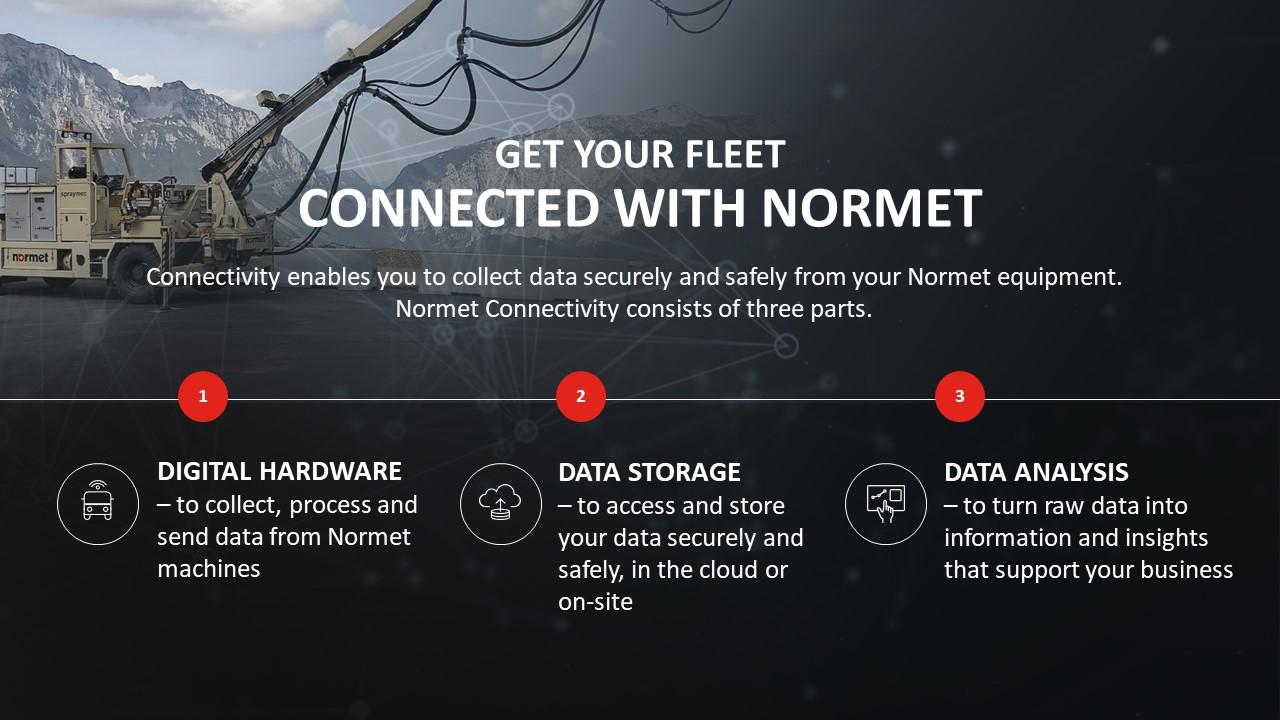August 28, 2022
Improve your business by collecting relevant data
During my studies at the Helsinki University of Technology I took a course on ”The Balanced Scorecard,” which is based on the strategic management tool that links a company’s current actions with its long-term goals. I still remember one famous phrase from that course: “What you measure is what you get” by Robert Kaplan and David Norton, who are the authors of the Balanced Scorecard concept. One of their philosophy’s basic ideas is that you need to collect and measure data about your business performance in order to improve it. Even though the idea of collecting and measuring data is not new, the concept of getting data to improve your business is more relevant than ever as technical capabilities advance.
We at Normet want to help you to improve your business by enabling relevant data collection from Normet’s equipment.
Normet sees data collection today as an integrated part of equipment and not as a standalone feature or solution. Normet has made the decision to connect all new intelligent equipment coming out of our factories starting from 2023. Connectivity enables you to collect data securely and safely from your equipment. With data you can improve your processes, increase both uptime and lifetime of your equipment, increase transparency in operations and accelerate research and development. But what does connectivity mean?
Connectivity at Normet consists of three parts: the digital hardware, data storage, and data analysis.

Connectivity with Normet
1. Digital Hardware
To get the data out from the equipment you will need to have a physical box that acts as a gateway between the equipment and the data storage. At Normet, we call our physical box the ‘edge module’. This module will interact with sensors and the control system and read data that we want to collect. It can then pre-process the data, which is called edge computing, hence the name of the box. Edge computing means that you do the calculation close to the source. This will reduce the amount of data sent to the cloud and hence improve the data transfer speed. There is one specific element in mining that differs from normal connectivity, and that’s network availability. In mining conditions, equipment may work longer in a place where there is no network. Because of this, edge modules used underground, need to be able to store the data and then send it once the equipment reaches a network. Normet’s edge module is designed for this purpose and can store data for a certain period of time. Finally, the box sends the data using a selected network, WiFi/3G/LTE/4G, to the data storage. This means that there needs to be a proper network in the mine or tunnel. Without the network, data collection is still possible, but will be limited, for example, to areas where there are WiFi-networks such as service workstations.
2. Data Storage
The main purpose of data storage is the ability to access and store data securely. In mining, the solution can be either a local server, a cloud, or a combination of both. When selecting the solution, you need to bear in mind the set-up time and costs and how easily the data is then accessed by your own organisation. The server or cloud needs to be able to receive the data from the edge module and store it. The connection can either be a one-way or two-way connection. One-way means that the equipment can only send data to the cloud. Two-way means that the cloud can send commands and requests back to the edge module. With two-way connections, software can be updated remotely, parameters changed, and in the future equipment could even be operated remotely.
At Normet, we can store data on the customer’s behalf in the cloud. We have the capabilities to easily give access to our customer’s own data. This is the key in data-driven organisations – not only is data stored, but also people needing the data can easily access it.
3. Data Analysis
We are collecting around 100 data points per piece of equipment, depending on the model of the equipment. Our new ‘SmartDrive’ equipment with electrical motors is sending more data while older diesel equipment is sending less. The amount of data we can collect is great. This also raises the issue of determining what data is relevant and how we can best utilize it.
In mining and tunnelling, some customers are advanced on this front. They have the needed technical capabilities and their own teams of data engineers, analysts, and scientists. There are also customers who are only now waking up to the era of data. Our offering at Normet has also been shaped by all of these various needs. We can offer our customer portal that displays the collected data in easy understandable graphs. And we can also offer more advanced data sharing from Normet’s cloud. This way the team can easily access the data, use their own preferred data analytics tools like Power BI or Tableau, or even integrate the data into their own dashboards.
All of these three parts need to be in place for your organisation to start utilising data from equipment in decision-making and to improve your operations. And to improve your business, you will need to have the relevant data in place to make the right decisions.
About the author

Eric Stigzelius
Senior Manager of Connected Solutions at Normet
Bio
Stigzelius has over 10 years of expertise in digitalisation in a variety of roles and industries.
Eric Stigzelius - LinkedIn Profile